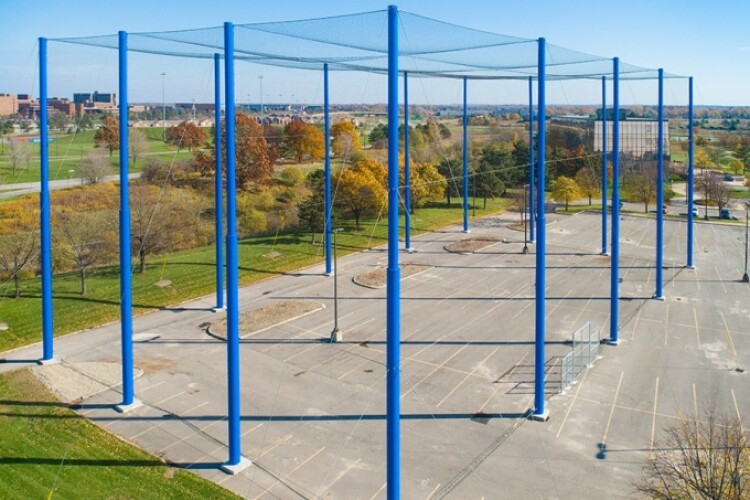The 24,000-square-foot Structure for Outdoor Autonomy Research (Soar) is covered with netting between blue support poles.
The facility is about 36m wide, 60m long and 26m tall. Gorilla Netting designed and built the netting system using staged steel poles and more than 7,300m2 of 100mm knotted nylon netting.
University at Buffalo consultants first approached Gorilla Netting in early 2019. For over a year, the team at Gorilla Netting worked with consultants and UB, to design, engineer and install the netted drone enclosure system for unmanned aerial vehicle (UAV) testing and research. “Many private companies and universities across the country have benefited from netted drone enclosure systems, and other organisations are moving forward with innovative netting systems,” said Dolvin Todd, president of Gorilla Netting.
“Our plan is to leave the netting up year-round. This will enable us to conduct tests and improve the performance of UAVs in the often-harsh winter weather conditions that we encounter,” said Chase Murray, assistant professor in the Department of Industrial & Systems Engineering.

The netted facility will be used by UB faculty, students and partners to conduct experiments on unmanned aerial vehicles (UAVs), also known as drones.
“The University at Buffalo is committed to addressing society’s most challenging issues,” said Kemper Lewis, dean of the School of Engineering & Applied Sciences.. By creating a research complex dedicated to exploring the tremendous potential of un-crewed aerial vehicles, UB researchers, students and our partners will advance cutting-edge solutions that can help global food security challenges, disaster response and anti-terrorism,” says
Because it is enclosed, and thus considered an indoor flight facility, researchers will not be subject to Federal Aviation Administration rules when testing UAVs. Researchers will use the facility to conduct research on:
- autonomous technology, which involves UAVs, as well as self-driving vehicles, which the university tests in the area outside the complex;
- sensors and surveillance for applications in areas including military, law enforcement, wildfire monitoring and bridge and building inspections;
- small parcel delivery and logistics;
- drone fleets - UB researchers are exploring how drones can work together in emergency situations.
The facility will also be a resource for undergraduate and graduate students who study robotics and computer vision. In addition, it will benefit Western New York companies interested in using the complex to test UAV hardware.
Got a story? Email news@theconstructionindex.co.uk



